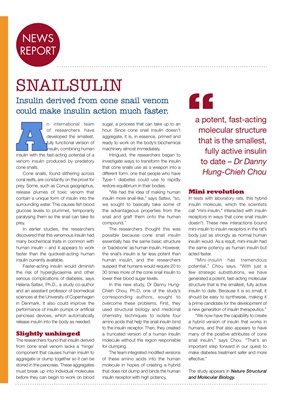
NEWS
NEWS
REPORT
Insulin derived from cone snail venom
could make insulin action much faster.
SNAILSULIN
A
n international team
of researchers have
developed the smallest,
fully functional version of
insulin, combining human
insulin with the fast-acting potential of a
venom insulin produced by predatory
cone snails.
Cone snails, found slithering across
coral reefs, are constantly on the prowl for
prey. Some, such as Conus geographus,
release plumes of toxic venom that
contain a unique form of insulin into the
surrounding water. This causes fish blood
glucose levels to plummet, temporarily
paralysing them so the snail can take its
prey.
In earlier studies, the researchers
discovered that this venomous insulin had
many biochemical traits in common with
human insulin - and it appears to work
faster than the quickest-acting human
insulin currently available.
Faster-acting insulin would diminish
the risk of hyperglycaemia and other
serious complications of diabetes, says
Helena Safavi, Ph.D., a study co-author
and an assistant professor of biomedical
sciences at the University of Copenhagen
in Denmark. It also could improve the
performance of insulin pumps or artificial
pancreas devices, which automatically
release insulin into the body as needed.
Slightly unhinged
The researchers found that insulin derived
from cone snail venom lacks a 'hinge'
component that causes human insulin to
aggregate or clump together so it can be
stored in the pancreas. These aggregates
must break up into individual molecules
before they can begin to work on blood
sugar, a process that can take up to an
hour. Since cone snail insulin doesn't
aggregate, it is, in essence, primed and
ready to work on the body's biochemical
machinery almost immediately.
Intrigued, the researchers began to
investigate ways to transform the insulin
that cone snails use as a weapon into a
different form: one that people who have
Type-1 diabetes could use to rapidly
restore equilibrium in their bodies.
"We had the idea of making human
insulin more snail-like," says Safavi, "so,
we sought to basically take some of
the advantageous properties from the
snail and graft them onto the human
compound."
The researchers thought this was
possible because cone snail insulin
essentially has the same basic structure
or 'backbone' as human insulin. However,
the snail's insulin is far less potent than
human insulin, and the researchers
suspect that humans would require 20 to
30 times more of the cone snail insulin to
lower their blood sugar levels.
In this new study, Dr Danny HungChieh
Chou, Ph.D, one of the study's
corresponding authors, sought to
overcome these problems. First, they
used structural biology and medicinal
chemistry techniques to isolate four
amino acids that help the snail insulin bind
to the insulin receptor. Then, they created
a truncated version of a human insulin
molecule without the region responsible
for clumping.
The team integrated modified versions
of these amino acids into the human
molecule in hopes of creating a hybrid
that does not clump and binds the human
insulin receptor with high potency.
Mini revolution
In tests with laboratory rats, this hybrid
insulin molecule, which the scientists
call "mini-insulin," interacted with insulin
receptors in ways that cone snail insulin
doesn't. These new interactions bound
mini-insulin to insulin receptors in the rat's
body just as strongly as normal human
insulin would. As a result, mini-insulin had
the same potency as human insulin but
acted faster.
"Mini-insulin has tremendous
potential," Chou says. "With just a
few strategic substitutions, we have
generated a potent, fast-acting molecular
structure that is the smallest, fully active
insulin to date. Because it is so small, it
should be easy to synthesise, making it
a prime candidate for the development of
a new generation of insulin therapeutics."
"We now have the capability to create
a hybrid version of insulin that works in
humans, and that also appears to have
many of the positive attributes of cone
snail insulin," says Chou. "That's an
important step forward in our quest to
make diabetes treatment safer and more
effective."
The study appears in Nature Structural
and Molecular Biology.
a potent, fast-acting
molecular structure
that is the smallest,
fully active insulin
to date - Dr Danny
Hung-Chieh Chou
"